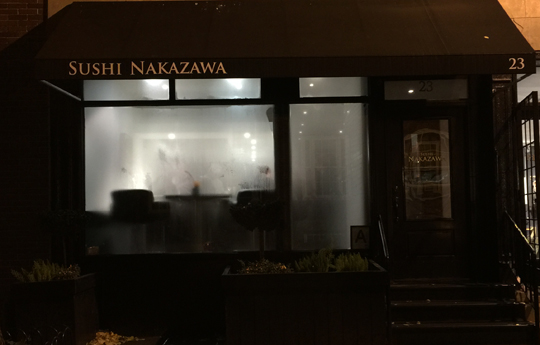Sushi Nakazawa
 Monday, December 8, 2014 at 08:14PM
Monday, December 8, 2014 at 08:14PM 
 I’ve never really found it that difficult to get into popular restaurants. It may require advance planning, such as calling the exact day that tables open up, 30 days in advance, at the exact hour the reservations line opens. Or perhaps the opposite—walking in at 5:30 and sitting at the bar. But it can almost always be done.
I’ve never really found it that difficult to get into popular restaurants. It may require advance planning, such as calling the exact day that tables open up, 30 days in advance, at the exact hour the reservations line opens. Or perhaps the opposite—walking in at 5:30 and sitting at the bar. But it can almost always be done.
Perhaps the toughest challenge was Momofuku Ko, when it was new. There was a science of out-dueling the restaurant’s notoriously finicky website. Even the New York Times critic, Frank Bruni, admitted he relied on “tireless friends and readers” to get him in. I wrote a series of posts about reserving there, which I finally did on the third or fourth try.
My Ko Kwest was child’s play compared to Sushi Nakazawa, the toughest table in town since Pete Wells gave it four stars last December. Reservations open at midnight, thirty days in advance. Four times, I tried exactly at midnight to book the 10-seat dining counter, and failed. Finally, I settled for the 25-seat dining room. This was fifteen months after the restaurant opened. By the time Momofuku Ko was in its second year, reservations at its 14-seat kounter were reasonably easy to come by.
The restaurant’s backstory has been much repeated. In the film Jiro Dreams of Sushi, chef Daisuke Nakazawa was the apprentice who cried when, after 200 tries, he finally made an egg custard that his master, Jiro Ono, found acceptable. Alessandro Borgognone, owner of Patricia’s Italian restaurant in the Bronx, saw the film, found Nakazawa on Facebook, and lured him to New York.
Sushi Nakazawa is not a four-star restaurant. Pete Wells’s review made no sense, even if you assume that everything he wrote was true. How do you put Sushi Nakazawa on a pedastal occupied by only five other restaurants, when you concede that “not everything is the best in town,” and “the $450 menu at Masa may glide to a higher pitch of pleasure”?
Yes indeed, Masa is better. Nevertheless, if your standard is “pleasure per dollar spent,” Sushi Nakazawa is certainly compelling. To the owner’s credit, and unlike just about every other three- and four-star restaurant, he has not jacked up the prices since the review came out. It’s still just $150 for the omakase at the counter, $120 at the tables. (You cannot order à la carte, unless you want extra pieces after your set menu is over.)
An excellent sake pairing is just $40 a head; for $80 you can have a premium pairing, but you’ll do fine at the lower price. (I’m not sure you can drink water at Masa for $40.) If you drink à la carte, your options are abundant but not cheap, with sake $16–29 by the glass, $65–1,600 by the bottle. There’s also a pretty good list of non-Japanese wines, including many by the half-bottle. The list is available online now; until recently, it wasn’t.

Sushi dining anywhere but the counter obviously entails some compromises. The dining room cannot possibly be the ideal way to experience the restaurant. The staff make the best of it. There’s an army of well-dressed servers. They whisk each serving to your table while the rice is still warm. But the noise level is so punishing that you can barely hear them when they try to explain what is on the plate. Bear that in mind if the descriptions below seem a little, er, sketchy.


Two kinds of salmon (above left); Sea scallop and squid (above right).


Three kinds of white fish (above left); two kinds of mackerel (above right).


Two kinds of shrimp (above left); Three white fish with mustard and ginger (above right).


Bluefin tuna, lean and fatty (above left); Salmon roe and uni (above right).


Egg custard and sea eel (above left); Dessert of green tea and lychee sorbet (above right).
*
There are drawbacks: most guests are stuck in the loud dining room. The mandatory omakase does not allow the dialogue between chef and diner that makes the best sushi restaurants so special, unless you order extra pieces at the end, by which time you’re probably too sated to appreciate them. Both Pete Wells and Eater’s Ryan Sutton mentioned various service blemishes. We experienced none of those, though we noticed an unusually messy bathroom—nothing you haven’t seen before, but this is purportedly a four-star restaurant.
None of this seems to matter to a crowd (mostly in their 20s and 30s) that still packs Sushi Nakazawa. This is obviously sushi on a high level. The restaurant does nothing else, not even sashimi: it sings the virtues of doing one thing exceptionally well. Each piece is seasoned perfectly, and if you can get in, you could experience it three times for the cost of one visit to Masa.
Sushi Nakazawa (23 Commerce Street, near Seventh Ave. South, West Village)
Food: All sushi, all the time, exquisitely prepared
Service: Very good, with inherent limitations
Ambiance: A black lacquer dining room, louder than you want it to be
Rating: ★★★



Reader Comments